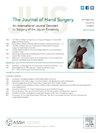Nonsurgical Treatment Versus Intramedullary Fixation of Displaced Metacarpal Shaft Fractures
IF 2.1
2区 医学
Q2 ORTHOPEDICS
引用次数: 0
Abstract
Purpose
Retrograde intramedullary headless compression screw (IMHS) fixation offers potential advantages over traditional surgical treatment of metacarpal shaft fractures. The purpose of this study was to compare the rates of recovery of short-term functional outcomes for displaced metacarpal shaft fractures treated nonsurgically and those treated using a minimally invasive intramedullary screw technique. We hypothesized that IMHS fixation would lead to earlier return of function with equivalent outcomes at final follow-up.
Methods
We identified patients between 2017 and 2022 with a displaced metacarpal shaft fracture treated nonsurgically or with IMHS. We included patients aged 18–65 years with a minimum 12 week follow up. We excluded open fractures and those presenting >1 week from injury. We documented radiographic displacement, grip strength, visual analog scale pain scores, total active motion (TAM), return to work (RTW), time to union, complications, and treatment cost. We performed a linear regression analysis to compare outcomes over time and survival curves for RTW.
Results
Ninety-nine patients with 109 fractures were included. Intramedullary headless compression screw fixation demonstrated less radiographic shortening (2.4 vs 5.1 mm) and angulation at 12 weeks (2° vs 30°) compared with nonsurgical management. There was significantly faster normalization of grip strength in the IMHS group during the first 6 weeks. At 12 weeks, there was no significant difference between the IMHS and nonsurgical groups in TAM, pain, or grip strength. The IMHS group had faster return to light (1.2 vs 2.1 weeks) and heavy-duty work (3.1 vs 6.1 weeks). Average direct cost was $1,413 and $2,452 for nonsurgical and IMHS patients, respectively.
Conclusions
The IMHS group demonstrated earlier return of grip strength and RTW compared with nonsurgical treatment. Intramedullary headless compression screw fixation improved radiographic parameters at 12 weeks without a difference in TAM, grip strength, or visual analog scale pain scores. The direct cost was higher by $1,039 with IMHS fixation.
Type of study/level of evidence
Therapeutic IV.
非手术治疗与髓内固定治疗移位的掌骨骨折。
目的:逆行髓内无头加压螺钉(IMHS)固定相对于传统手术治疗掌骨骨干骨折具有潜在的优势。本研究的目的是比较非手术治疗和微创髓内螺钉治疗的短期功能恢复率。我们假设IMHS固定可导致早期功能恢复,并在最终随访中获得相同的结果。方法:我们选取了2017年至2022年间非手术或IMHS治疗的移位型掌骨骨折患者。我们纳入了年龄在18-65岁之间的患者,随访时间至少为12周。我们排除了开放性骨折和损伤后1周出现bbb10的患者。我们记录了x线片位移、握力、视觉模拟疼痛评分、总主动运动(TAM)、重返工作(RTW)、愈合时间、并发症和治疗费用。我们进行了线性回归分析,比较RTW随时间的结果和生存曲线。结果:纳入99例109例骨折患者。与非手术治疗相比,髓内无头加压螺钉固定在12周时显示更少的x线缩短(2.4 vs 5.1 mm)和成角(2°vs 30°)。在前6周,IMHS组握力恢复明显更快。12周时,IMHS组与非手术组在TAM、疼痛或握力方面无显著差异。IMHS组恢复较轻(1.2周vs 2.1周)和重负荷(3.1周vs 6.1周)更快。非手术和IMHS患者的平均直接成本分别为1413美元和2452美元。结论:与非手术治疗相比,IMHS组握力和RTW恢复较早。髓内无头加压螺钉固定改善了12周时的影像学参数,TAM、握力或视觉模拟疼痛评分均无差异。IMHS固定的直接费用增加了1039美元。证据等级:治疗性IV级。
本文章由计算机程序翻译,如有差异,请以英文原文为准。
求助全文
约1分钟内获得全文
求助全文
来源期刊
CiteScore
3.20
自引率
10.50%
发文量
402
审稿时长
12 weeks
期刊介绍:
The Journal of Hand Surgery publishes original, peer-reviewed articles related to the pathophysiology, diagnosis, and treatment of diseases and conditions of the upper extremity; these include both clinical and basic science studies, along with case reports. Special features include Review Articles (including Current Concepts and The Hand Surgery Landscape), Reviews of Books and Media, and Letters to the Editor.

 求助内容:
求助内容: 应助结果提醒方式:
应助结果提醒方式:


